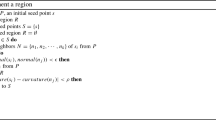Abstract
Three-dimensional point cloud registration is important in reverse engineering. In this paper, we propose a registration method for large-scale 3D point clouds, which is based on neighborhood constraints of geometrical features. The method consists of initial and exact registration steps.In the process of initial registration, we define a new functon that measures feature similarity by calculating the distance function, and in the process of exact registration, we introduce the angle information that improve the accuracy of iterative closest point algorithm. Compared with the traditional feature-based and iterative closest point algorithms, our method significantly reduced the registration time by 11.9 % and has only 1 % of the registration error of the traditional feature-based algorithm. The proposed algorithm can be used to create efficient 3D models for virtual plant reconstruction and computer-aided design, and the registration results can provide a reference for virtual plant reconstruction and growth.










Similar content being viewed by others
References
Basdogan C, Oztireli AC (2008) A new feature-based method for robust and efficient rigid-body registration of overlapping point clouds. Vis Comput 24(7-9):679–688
Besl PJ, McKay ND (1992) Method for registration of 3-D shapes. In: Robotics-DL tentative (pp. 586-606). International Society for Optics and Photonics
Chen Y, Medioni G (1991) Object modeling by registration of multiple range images. In: Robotics and Automation, 1991. Proceedings., 1991 IEEE International Conference on (pp. 2724-2729). IEEE
Cheng L, Tong L, Li M, Liu Y (2013) Semi-automatic registration of airborne and terrestrial laser scanning data using building corner matching with boundaries as reliability check. Remote Sens 5(12):6260–6283
Cheng ZQ, Wang YZ, Li B, Xu K, Dang G, Jin SY (2008) A Survey of Methods for Moving Least Squares Surfaces. In: Volume Graphics, pp 9–23
Dai J, Yang J (2011) A novel two-stage algorithm for accurate registration of 3-D point clouds. In: Multimedia Technology (ICMT), 2011 International Conference on (pp. 6187-6191). IEEE
Daniels Ii J, Ochotta T, Ha LK, Silva CT (2008) Spline-based feature curves from point-sampled geometry. Vis Comput 24(6):449–462
Diez Y, Mart J, Salvi J (2012) Hierarchical normal space sampling to speed up point cloud coarse matching. Pattern Recogn Lett 33(16):2127–2133
Dos Santos DR, Dal Poz AP, Khoshelham K (2013) Indirect georeferencing of terrestrial laser scanning data using control lines. Photogramm Rec 28(143):276–292
Du S, Zheng N, Meng G, Yuan Z (2008) Affine registration of point sets using ICP and ICA. Signal Processing Letters. IEEE 15:689–692
Du S, Zheng N, Ying S, Liu J (2010) Affine iterative closest point algorithm for point set registration. Pattern Recogn Lett 31(9):791–799
Guan Y, Cheng X, Shi G (2008) A robust method for fitting a plane to point clouds [J]. J Tongji Univ (Nat Sci) 7:024
Hoppe H, DeRose T, Duchamp T, McDonald J, Stuetzle W (1992) Surface reconstruction from unorganized points (Vol. 26, No. 2, pp. 71-78). ACM
Huang T, Zhang D, Li G, Jiang M (2012) Registration method for terrestrial LiDAR point clouds using geometric features. Opt Eng 51(2):021114–1
Jiang J, Cheng J, Chen X (2009) Registration for 3-D point cloud using angular-invariant feature. Neurocomputing 72(16):3839–3844
Jing LD, Zhi YC, Xiu ZY (2007) The application of ICP algorithm in point cloud alignment. J Image Graph 12(3):517–521
Liao Y, Xu F, Zhao X, Hagiwara I (2014) A Point Cloud Registration Method Based on Point Cloud Region and Application Samples. In: AsiaSim 2014 (pp. 216-227). Springer, Berlin Heidelberg
Lou B, Zhong Y, Li R (2004) Data registration in3D scanning systems. J Tsinghua Univ (Sci Techn) 44(8):1104–1106
Mian AS, Bennamoun M, Owens RA (2006) A novel representation and feature matching algorithm for automatic pairwise registration of range images. Int J Comput Vis 66(1):19–40
Rusinkiewicz S, Levoy M (2001) Efficient variants of the ICP algorithm. In: 3-D Digital Imaging and Modeling, 2001 Proceedings. Third International Conference on (pp. 145-152). IEEE
Schindhelm CK (2012) Evaluating slam approaches for microsoft kinect. In: Proceedings 2011 The Eighth International Conference on Wireless and Mobile Communications (ICWMC 2012), Venice, pp 402–407
The standford 3D Scanning Repository (2003-04-01), Standford University Computer GraphicsLaboratory. http://www.graphics.stanford.edu/data/3Dscanrep/
Wei X, Jiexin P (2011) Point cloud integration base on distances between points and their neighborhood centroids. J Image Graph 5:886–891
Weinmann M, Jutzi B (2011) Fully automatic image-based registration of unorganized TLS data. Int Arch Photogramm Remote Sens Spat Inf Sci 38:1–6
Wu M, Zhou LS, Wang ZD, An LL (2003) Research of multi-view registration and integration on measured point cloud data. J Nanjing Univ Aeronaut Astronaut 35(5):552–557
Xie Z, Xu S, Li X (2010) A high-accuracy method for fine registration of overlapping point clouds. Image Vis Comput 28(4):563–570
Yang HJ, He DJ (2012) A simplified and accurate registration for splat-based fruit scans. ICIC Express Lett Part B: Appl 3(4):733–741
Yang J, Li H, Jia Y (2013) Go-icp: Solving 3d registration efficiently and globally optimally. In: Computer Vision (ICCV), 2013 IEEE International Conference on (pp. 1457-1464). IEEE
Yanjuan Z (2006) Registration of scattered cloud data. J Comput Aided Des Comput Graph 18(4):475
Zhang X, Xi J, Yan J (2005) Research on digital measurement technology based on point cloud data of complex surfaces. Comput Integr Manuf Syst-beijing 11(5):727
Zhang Z, Yuan L (2012) Building a 3D scanner system based on monocular vision. Appl Opt 51(11):1638–1644
Zhu J, Du S, Yuan Z, Liu Y, Ma L (2012) Robust affine iterative closest point algorithm with bidirectional distance. IET Comput Vis 6(3):252–261
Acknowledgments
This work was partially supported by the National High Technology Research and Development Program of China (863 Program) (No. 2013AA102304), Science and Technology Innovation Project (QN2013056), and Science and Technology Innovation Project (2014YB067).
Author information
Authors and Affiliations
Corresponding author
Rights and permissions
About this article
Cite this article
Geng, N., Ma, F., Yang, H. et al. Neighboring constraint-based pairwise point cloud registration algorithm. Multimed Tools Appl 75, 16763–16780 (2016). https://doi.org/10.1007/s11042-015-2941-6
Received:
Revised:
Accepted:
Published:
Issue Date:
DOI: https://doi.org/10.1007/s11042-015-2941-6




